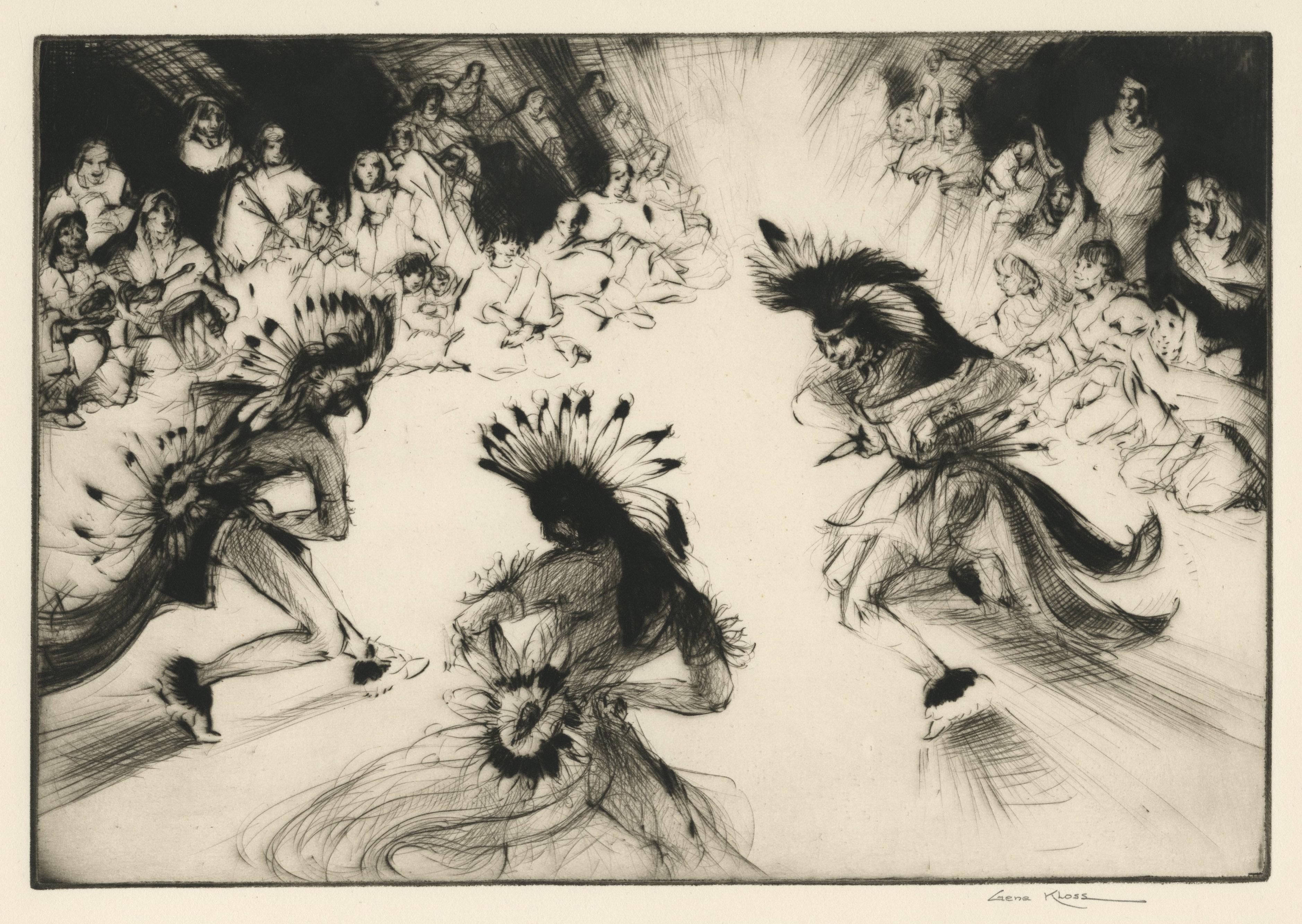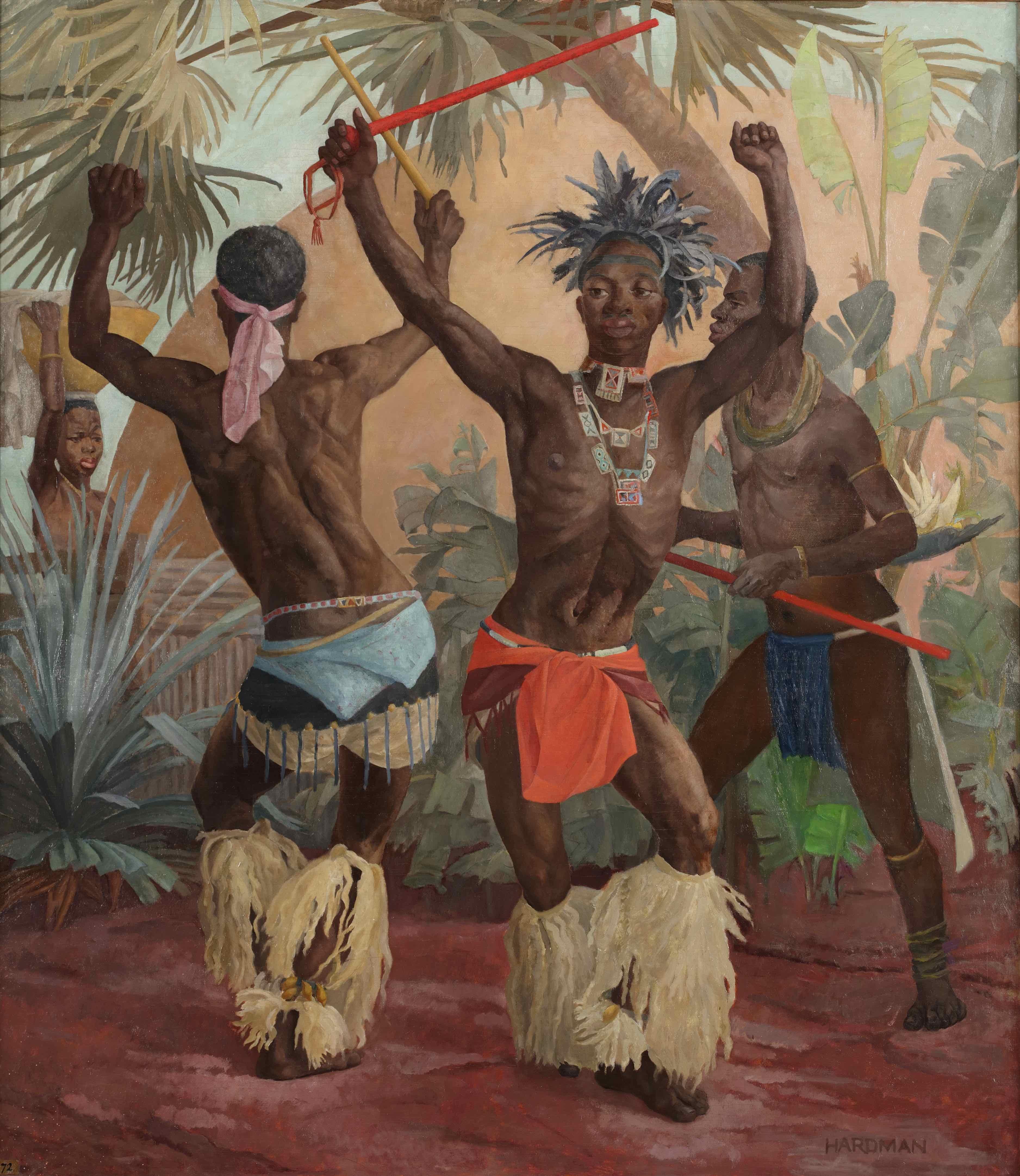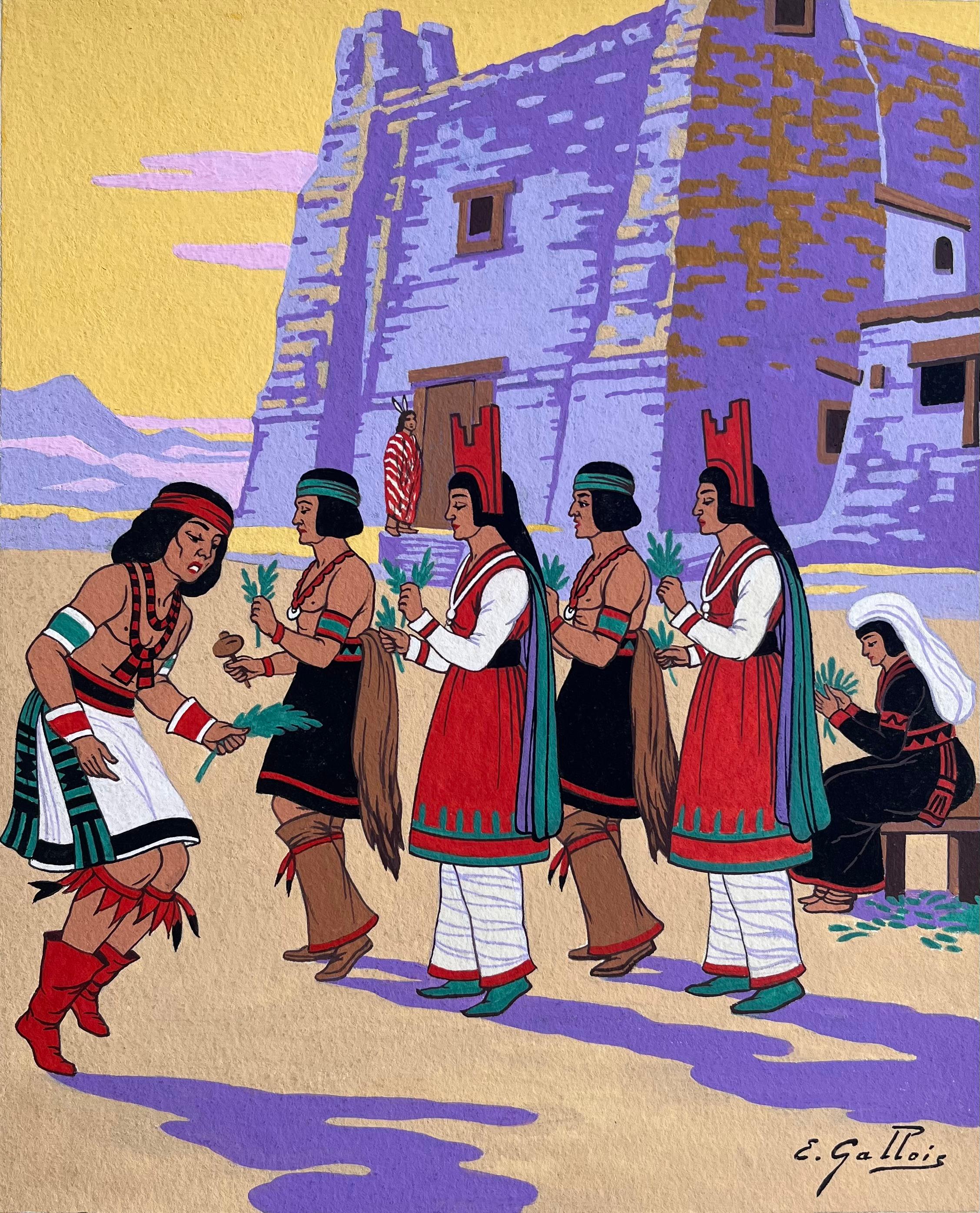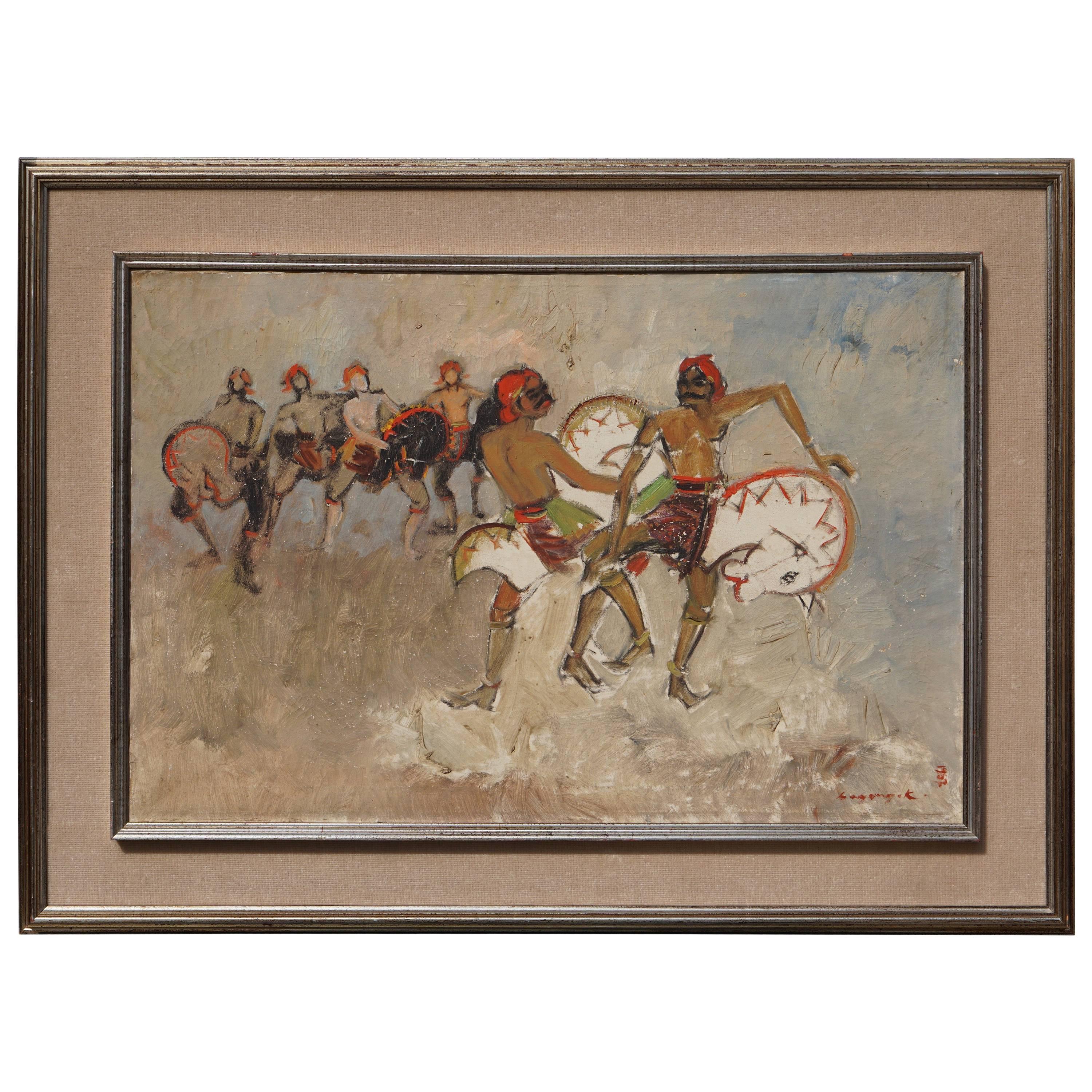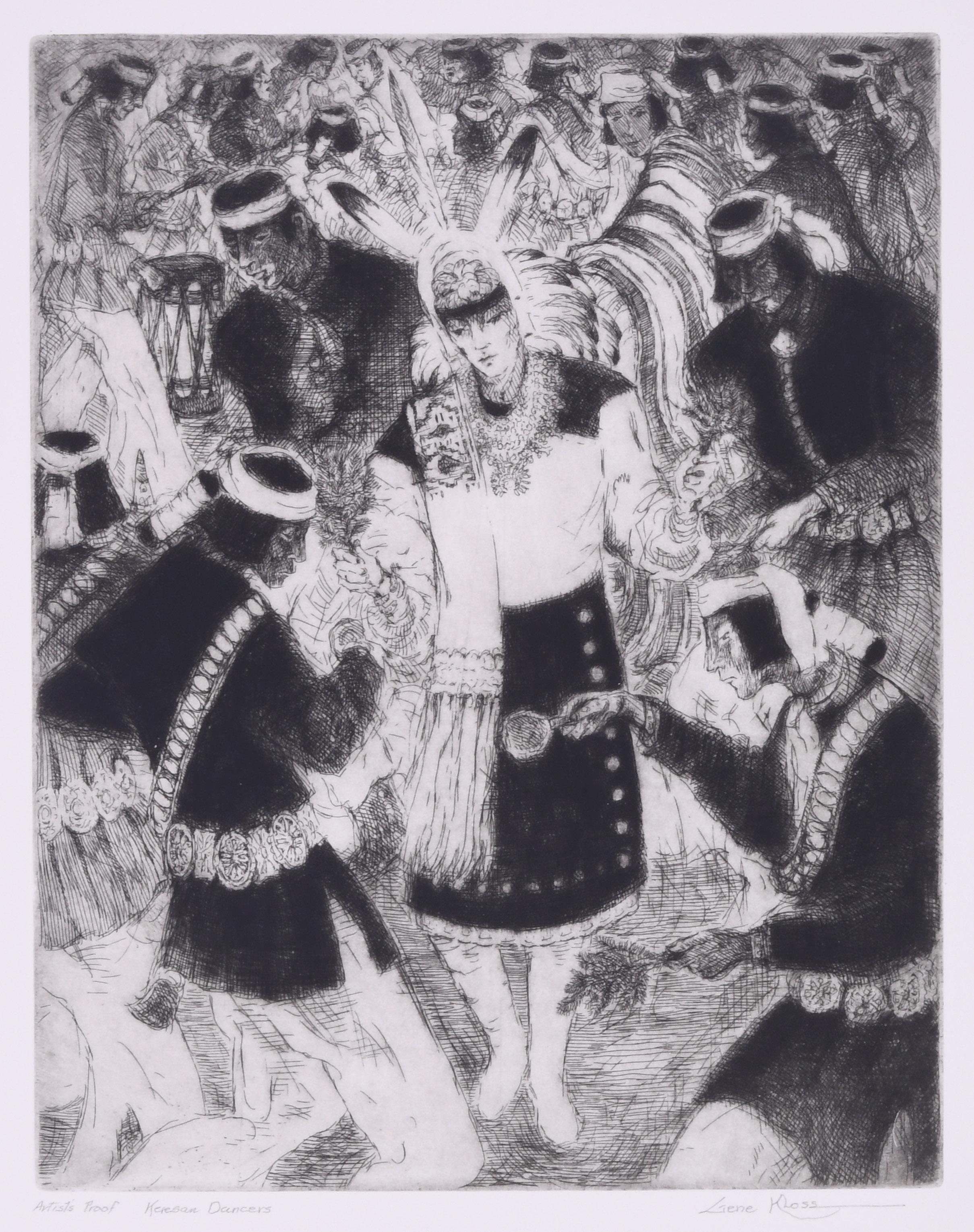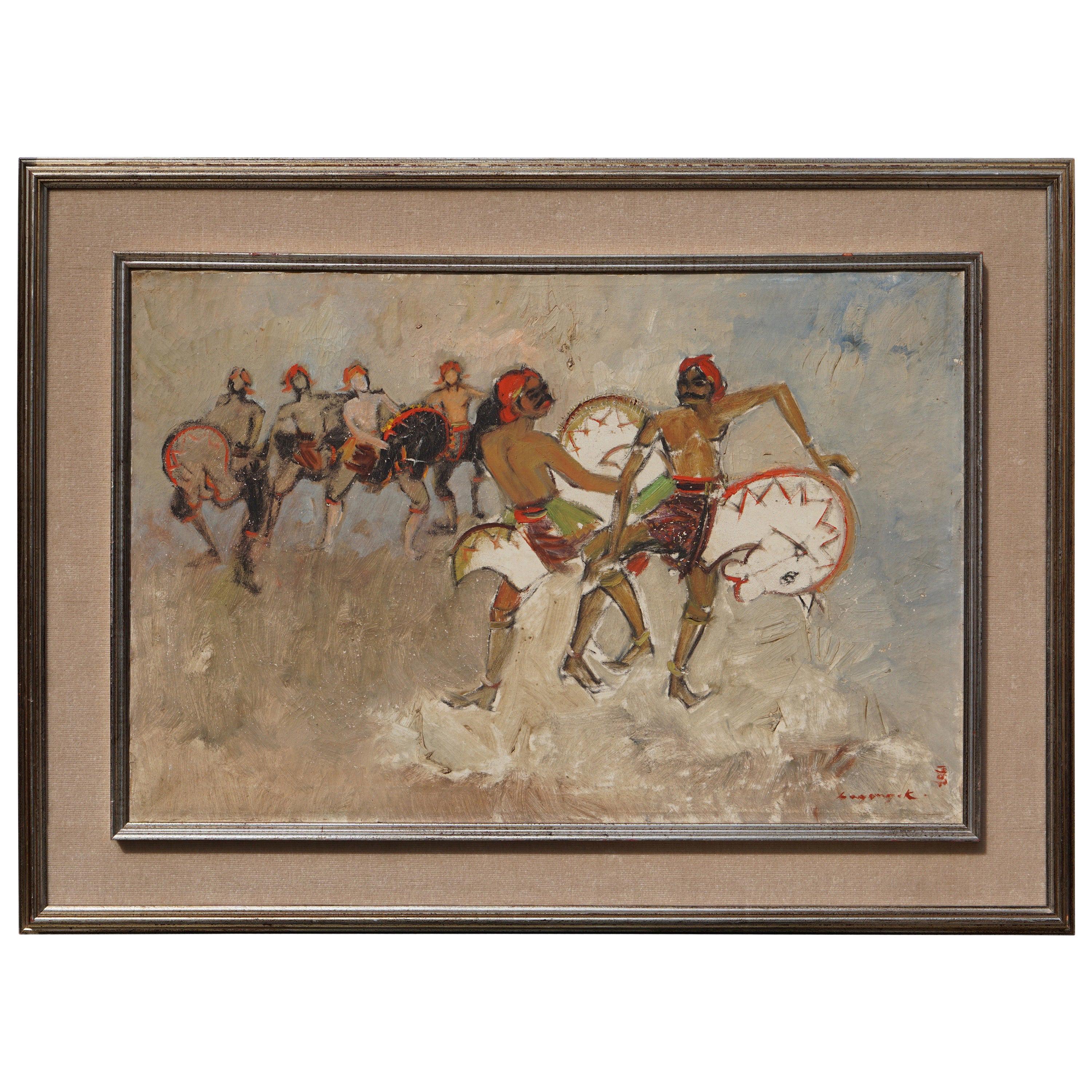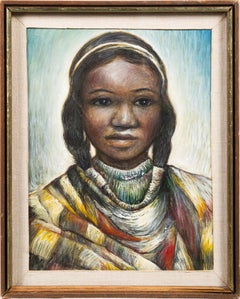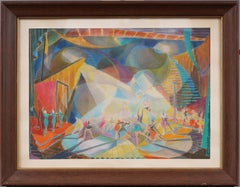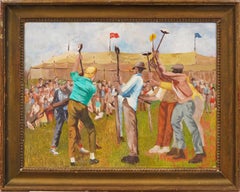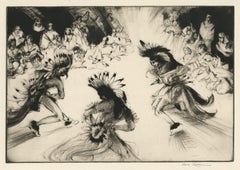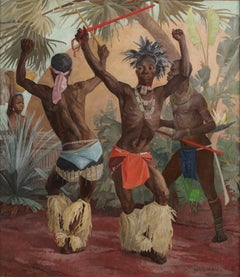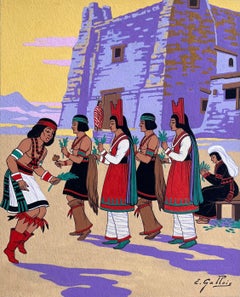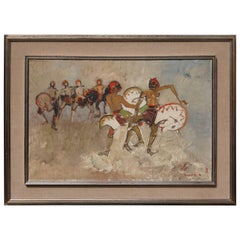Items Similar to American Painting Native American Dance Exhibition New Mexico Antelope Dancers
Want more images or videos?
Request additional images or videos from the seller
1 of 10
Rudolph WedowAmerican Painting Native American Dance Exhibition New Mexico Antelope Dancersc. 1940
c. 1940
$636
$79520% Off
£482.93
£603.6620% Off
€552.27
€690.3320% Off
CA$888.58
CA$1,110.7320% Off
A$988.30
A$1,235.3720% Off
CHF 516.06
CHF 645.0720% Off
MX$12,026.56
MX$15,033.1920% Off
NOK 6,590.87
NOK 8,238.5820% Off
SEK 6,181.07
SEK 7,726.3420% Off
DKK 4,121.78
DKK 5,152.2220% Off
Shipping
Retrieving quote...The 1stDibs Promise:
Authenticity Guarantee,
Money-Back Guarantee,
24-Hour Cancellation
About the Item
An original oil painting by American artist Rudolph Wedow. This fantastic painting depicts Antelope Dancers in San Felipe Pueblo in New Mexico.
Created in the 1940's and exhibited in 1967 at the Williams-Proctor Institute in Utica, NY.
The work comes housed in its original frame. The painting on the wall measures 20" x 24"
- Creator:Rudolph Wedow (1906 - 1965)
- Creation Year:c. 1940
- Dimensions:Height: 20 in (50.8 cm)Width: 24 in (60.96 cm)
- Medium:
- Movement & Style:
- Period:
- Condition:There are some minor areas of in-painting through out the piece only visible under blacklight. The frame has visible wear which does not distract from the overall presence on the wall.
- Gallery Location:Buffalo, NY
- Reference Number:1stDibs: LU13924759262
About the Seller
4.9
Platinum Seller
Premium sellers with a 4.7+ rating and 24-hour response times
Established in 1970
1stDibs seller since 2015
2,972 sales on 1stDibs
Typical response time: 5 hours
- ShippingRetrieving quote...Shipping from: Buffalo, NY
- Return Policy
Authenticity Guarantee
In the unlikely event there’s an issue with an item’s authenticity, contact us within 1 year for a full refund. DetailsMoney-Back Guarantee
If your item is not as described, is damaged in transit, or does not arrive, contact us within 7 days for a full refund. Details24-Hour Cancellation
You have a 24-hour grace period in which to reconsider your purchase, with no questions asked.Vetted Professional Sellers
Our world-class sellers must adhere to strict standards for service and quality, maintaining the integrity of our listings.Price-Match Guarantee
If you find that a seller listed the same item for a lower price elsewhere, we’ll match it.Trusted Global Delivery
Our best-in-class carrier network provides specialized shipping options worldwide, including custom delivery.More From This Seller
View AllVintage American Impressionist Taos School New Mexico Framed Portrait Painting
Located in Buffalo, NY
Antique American impressionist portrait oil painting. Oil on canvas. Framed. No signature found.
Category
1930s Impressionist Portrait Paintings
Materials
Canvas, Oil
$556 Sale Price
20% Off
Antique American Modernist Cubist Ballet Dancers Framed Original Painting
Located in Buffalo, NY
Very finely executed modernist ballet scene. Pastel and gouache on paper. Handsomely framed. Image size, 12H by 16L.
Category
1940s Cubist Abstract Paintings
Materials
Canvas, Oil
$620 Sale Price
20% Off
Native American Painting 1860 Montana Fort Owen Museum Rare Gold Frame Original
Located in Buffalo, NY
A rare mid 19th Century watercolor depicting Native Americans approaching a fort by Peter Peterson Tofft.
This painting depicts a Fort built by Major John Owen in what is now Steve...
Category
1840s American Realist Landscape Paintings
Materials
Paper, Watercolor, Gouache
Antique American Modernist WPA Social Realist Carnival Scene Framed Oil Painting
Located in Buffalo, NY
Impressive early American modernist carnival scene oil painting. Framed. Oil on board. Image size, 14H by 18L.
Category
1930s Modern Figurative Paintings
Materials
Canvas, Oil
$620 Sale Price
20% Off
Signed Antique African Modernist Figural Landscape Framed Oil Painting
Located in Buffalo, NY
Exceptionally well painted African landscape painting. Oil on board. Framed. Signed. Image size, 22L x 26H.
Category
1960s Modern Figurative Paintings
Materials
Canvas, Oil
$600 Sale Price
20% Off
Rare Large and Important Mexican Modernist Framed Landscape Signed Oil Painting
Located in Buffalo, NY
Rare and important large landscape painting by Paul Esteban (Pablo) O'Higgins (1904 - 1983). Oil on canvas. Signed lower right. Framed. Image size, 23.25L by 33.25H image size al...
Category
1950s Modern Landscape Paintings
Materials
Canvas, Oil
You May Also Like
Indian Friendship Dance
By Gene Kloss
Located in Fairlawn, OH
Indian Friendship Dance
Drypoint, 1953
Signed in pencil lower right, (see photo)
Edition 200
Published by The Society of American Graphic Artists, New York
An impression is in the collection of SAAM, Washington and RISD Museum,
Condition: Excellent
Very rich impression with burr and selective whiping of the ink for atmospheric nocturnal effect.
Image/Plate size: 8 3/16 x 11 15/16 inches
Sheet size: 11 1/8 x 17 inches
Reference: Kloss 450
"'Indian Friendship Dance' is an eloquent statement of something which Gene Kloss has both observed and participated in. It is an Indian dance that is thought of as entertainment, rather than ceremony, but it is essentially an idea expressed in action, and an idea that has universal meaning. The young men who dance wear costumes of exquisite workmanship, intricately wrought with beads and feathers and subtle combinations of colors. The dancers are trained from childhood but develop their own steps and exhibit distinctive strength and grace. Singers and a tom-tom accompany the dance and since it usually takes place at night, a campfire is the source of light. The conclusion occurs when all the onlookers, old and young and from many places, join hands with the dancers in a slow revolving movement, while those who can, sing the difficult but meaningful Indian song that flows with the rhythmical dance step and speaks of fellowship, brotherhood, friendship." - An excerpt from a descriptive statement, written by Lynd Ward, and distributed with the drypoint at the time of publication." Courtesy Old Print Shop
Born Alice Glasier in Oakland, CA, Kloss grew up amid the worldly bustle of the San Francisco Bay Area. She attended the University of California at Berkeley, graduating with honors in art in 1924. She discovered her talents in intaglio printmaking during a senior-year course in figurative drawing. The professor, Perham Nahl, held up a print from Kloss’ first plate, still damp from the printing process, and announced that she was destined to become a printmaker.
In 1925, Gene married Phillips Kloss, a poet and composer who became her creative partner for life. The match was uncanny, for in her own way Gene, too, was a poet and a composer. Like poetry, her artworks capture a moment in time; like music, her compositions sing with aesthetic harmony. Although she was largely self-taught, Kloss was a printmaking virtuoso.
On their honeymoon the Klosses traveled east from California, camping along the way. They spent two week is Taos Canyon – with a portable printing press cemented to a rock near their campsite – where Gene learned to appreciate the wealth of artistic subject matter in New Mexico. The landscape, the cultures, and the immense sky left an indelible impression on the couple, who returned every summer until they made Taos their permanent home 20 years later.
Throughout her life, Kloss etched more than 625 copper plates, producing editions ranging from five to 250 prints. She pulled every print in every edition herself, manually cranking the wheel of her geared Sturges press until she finally purchased a motorized one when she was in her 70s. Believing that subject matter dictated technique, she employed etching, drypoint, aquatint, mezzotint, roulette, softground, and a variety of experimental approaches, often combining several techniques on the same plate. She also produced both oil and watercolor paintings.
Kloss’ artworks are filled with drama. Her prints employ striking contrasts of darkness and light, and her subjects are often illuminated by mysterious light sources. Though she was a devout realist, there is also a devout abstraction on Kloss’ work that adds an almost mythical quality.
For six decades Kloss documented the cultures of the region-from images of daily life to those of rarely seen ceremonies. She and her husband shared a profound respect for the land and people, which made them welcome among the Native American and Hispanic communities. Kloss never owned a camera but relied instead on observation and recollection. Her works provide an inside look at the cultures she depicted yet at the same time communicate the awe and freshness of an outsider’s perspective.
Although Kloss is best known for her images of Native American and Penitente scenes, she found artistic inspiration wherever she was. During the early years of their marriage, when she and Phil returned to the Bay Area each winter to care for their aging families, she created images of the California coast. And when the Klosses moved to southwestern Colorado in 1965, she etched the mining towns and mountainous landscapes around her.
In 1970 the Klosses returned to Taos and built a house north of town. Though her artwork continued to grow in popularity, she remained faithful to Taos’ Gallery A, where she insisted that owner Mary Sanchez keep the prices of her work reasonable regardless of its market value. Kloss continued to etch until 1985, when declining health made printmaking too difficult.
From her first exhibition at San Francisco’s exclusive Gump’s in 1937 to her 1972 election to full membership in the National Academy of Design, Kloss experienced a selective fame. She received numerous awards, and though she is not as well known as members of the Taos Society of Artists...
Category
1950s American Realist Figurative Prints
Materials
Drypoint
'Zulu Dancers'
Located in Amsterdam, NL
‘Zulu Dancers’
Signed bottom right Hardman, titled on a sticker at the reverse and with address Walton End, Walton Lane, Bosham, Chichester, and Price 45 gns.
Oil on board, 99 x 87...
Category
20th Century Expressionist Nude Paintings
Materials
Oil, Board
French Gouache Painting of Acoma Pueblo Corn Dance in New Mexico
Located in Cirencester, Gloucestershire
Title: French Gouache Painting of Acoma Pueblo Corn Dance in New Mexico
by Emile GALLOIS (1882-1965, French)
Signed: Yes
Medium: Original gouache painting on thick unframed paper,
Si...
Category
Mid-20th Century American Modern Figurative Drawings and Watercolors
Materials
Gouache
Dancers Painting by Bagong Kussudiardja Indonesia 1950s
By Bagong Kussudiardja
Located in Antwerp, BE
Oil on canvas painting Signed by Bagong Kussudiardja.
Indonesian,1928-2004.
Dancers.
Dimensions including the wooden frame:
Width 95 cm.
height 70 cm.
Category
Mid-20th Century Indonesian Dutch Colonial Paintings
Materials
Wood, Canvas
$3,115 Sale Price
88% Off
Keresan Dancers
By Gene Kloss
Located in Fairlawn, OH
Keresan Dancers
Etching & drypoint, 1962
Signed lower right (see photo)
Inscribed lower left: "Artist's Proof Keresan Dancers"
Depicts Keresan speaking peoples at Sam Felipe Pueblo
Contemporary Puebloans are customarily described as belonging to either the eastern or the western division. The eastern Pueblo villages are in New Mexico along the Rio Grande and comprise groups who speak Tanoan and Keresan languages. Tanoan languages such as Tewa are distantly related to Uto-Aztecan, but Keresan has no known affinities. The western Pueblo villages include the Hopi villages of northern Arizona and the Zuni, Acoma, and Laguna villages, all in western New Mexico.
Born Alice Glasier in Oakland, CA, Kloss grew up amid the worldly bustle of the San Francisco Bay Area. She attended the University of California at Berkeley, graduating with honors in art in 1924. She discovered her talents in intaglio printmaking during a senior-year course in figurative drawing. The professor, Perham Nahl, held up a print from Kloss’ first plate, still damp from the printing process, and announced that she was destined to become a printmaker.
In 1925, Gene married Phillips Kloss, a poet and composer who became her creative partner for life. The match was uncanny, for in her own way Gene, too, was a poet and a composer. Like poetry, her artworks capture a moment in time; like music, her compositions sing with aesthetic harmony. Although she was largely self-taught, Kloss was a printmaking virtuoso.
On their honeymoon the Klosses traveled east from California, camping along the way. They spent two week is Taos Canyon – with a portable printing press cemented to a rock near their campsite – where Gene learned to appreciate the wealth of artistic subject matter in New Mexico. The landscape, the cultures, and the immense sky left an indelible impression on the couple, who returned every summer until they made Taos their permanent home 20 years later.
Throughout her life, Kloss etched more than 625 copper plates, producing editions ranging from five to 250 prints. She pulled every print in every edition herself, manually cranking the wheel of her geared Sturges press until she finally purchased a motorized one when she was in her 70s. Believing that subject matter dictated technique, she employed etching, drypoint, aquatint, mezzotint, roulette, softground, and a variety of experimental approaches, often combining several techniques on the same plate. She also produced both oil and watercolor paintings.
Kloss’ artworks are filled with drama. Her prints employ striking contrasts of darkness and light, and her subjects are often illuminated by mysterious light sources. Though she was a devout realist, there is also a devout abstraction on Kloss’ work that adds an almost mythical quality.
For six decades Kloss documented the cultures of the region-from images of daily life to those of rarely seen ceremonies. She and her husband shared a profound respect for the land and people, which made them welcome among the Native American and Hispanic communities. Kloss never owned a camera but relied instead on observation and recollection. Her works provide an inside look at the cultures she depicted yet at the same time communicate the awe and freshness of an outsider’s perspective.
Although Kloss is best known for her images of Native American and Penitente scenes, she found artistic inspiration wherever she was. During the early years of their marriage, when she and Phil returned to the Bay Area each winter to care for their aging families, she created images of the California coast. And when the Klosses moved to southwestern Colorado in 1965, she etched the mining towns and mountainous landscapes around her.
In 1970 the Klosses returned to Taos and built a house north of town. Though her artwork continued to grow in popularity, she remained faithful to Taos’ Gallery A, where she insisted that owner Mary Sanchez keep the prices of her work reasonable regardless of its market value. Kloss continued to etch until 1985, when declining health made printmaking too difficult.
From her first exhibition at San Francisco’s exclusive Gump’s in 1937 to her 1972 election to full membership in the National Academy of Design, Kloss experienced a selective fame. She received numerous awards, and though she is not as well known as members of the Taos Society of Artists...
Category
1960s American Realist Figurative Prints
Materials
Drypoint
Dancers Painting by Bagong Kussudiardja, Indonesia, 1950s
By Bagong Kussudiardja
Located in Antwerp, BE
Dancers.
Oil on canvas painting with dancing people signed by Bagong Kussudiardja.
Indonesia, 1928-2004.
Dimensions including the wooden ...
Category
Mid-20th Century Indonesian Mid-Century Modern Paintings
Materials
Wood
